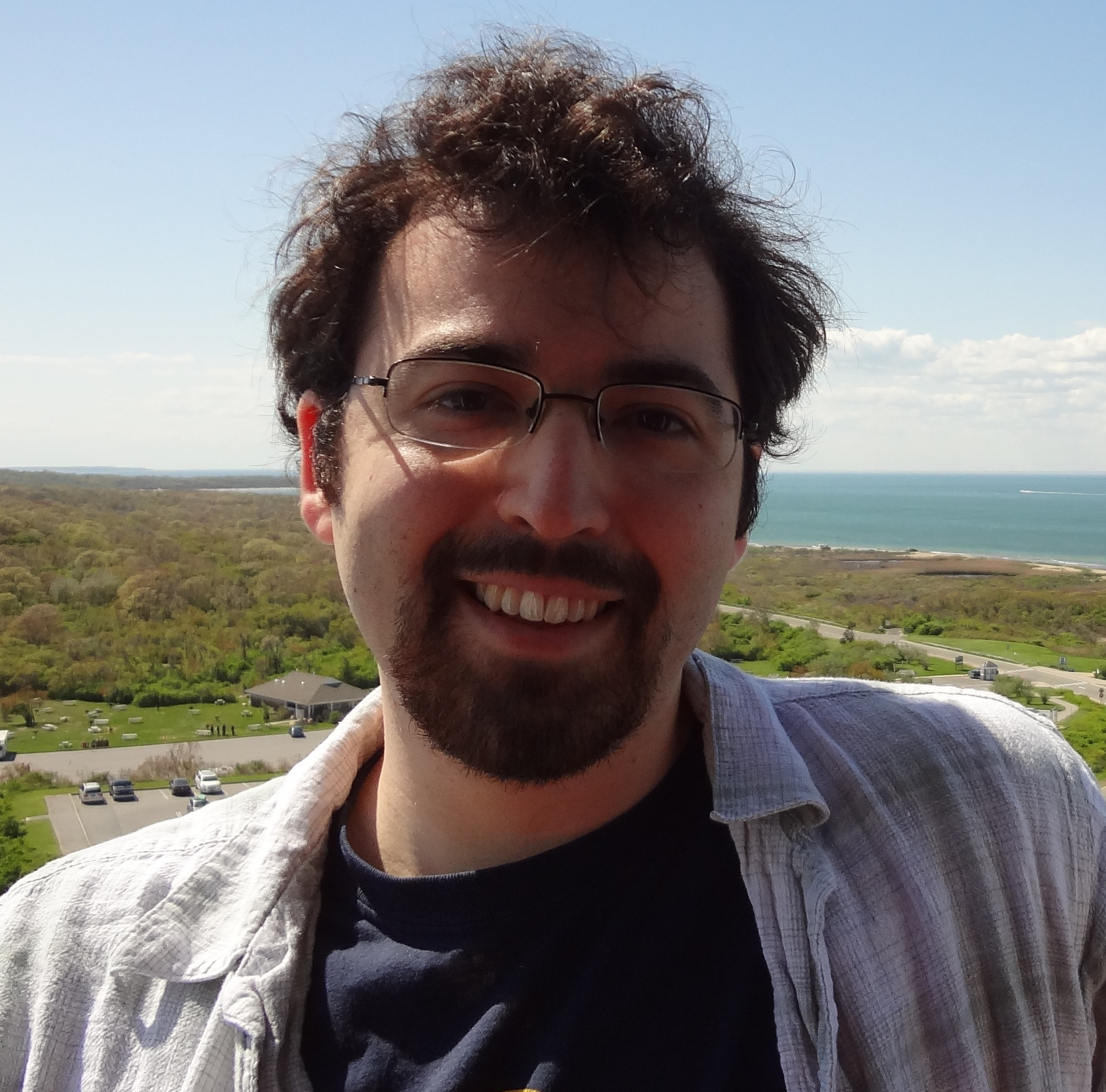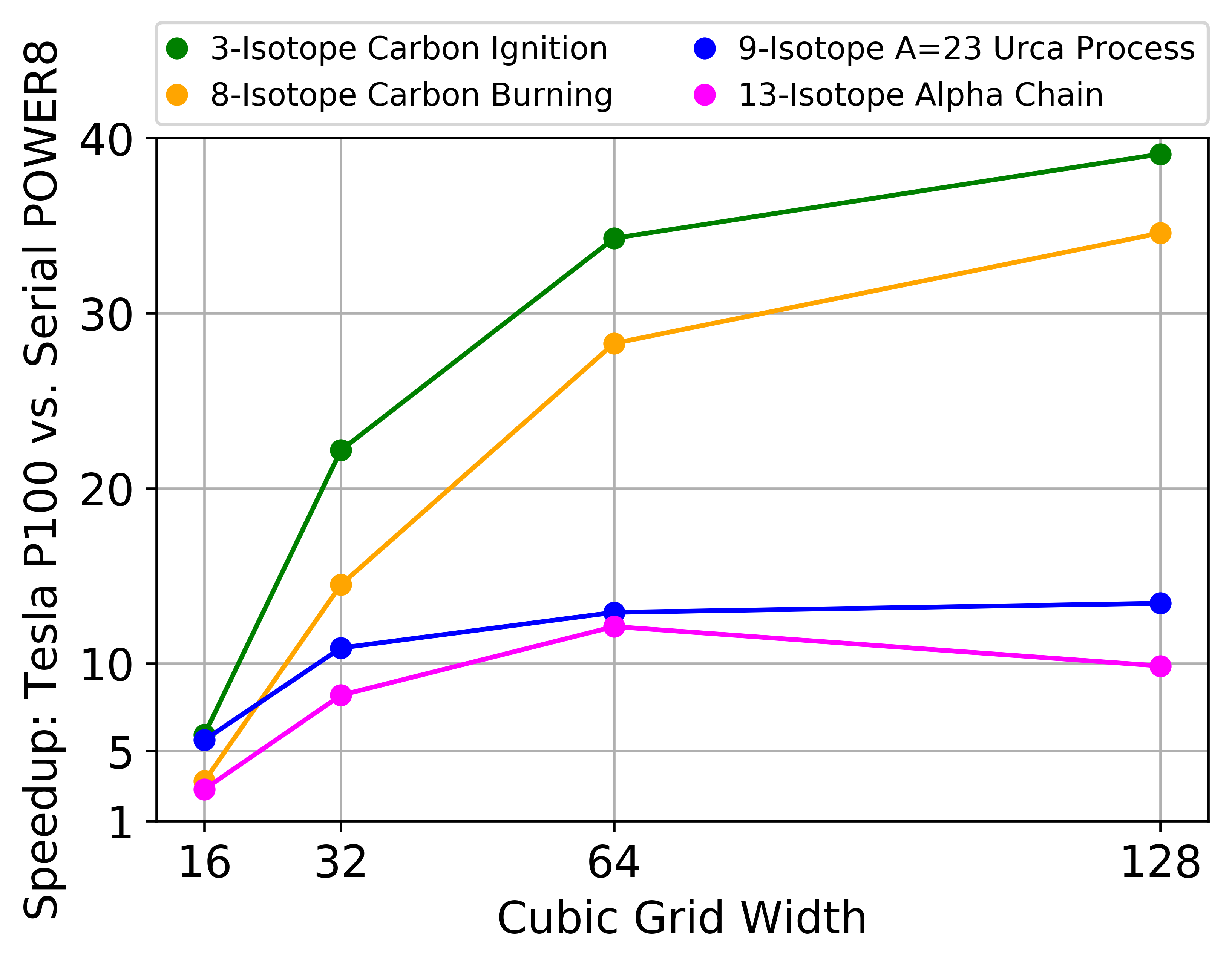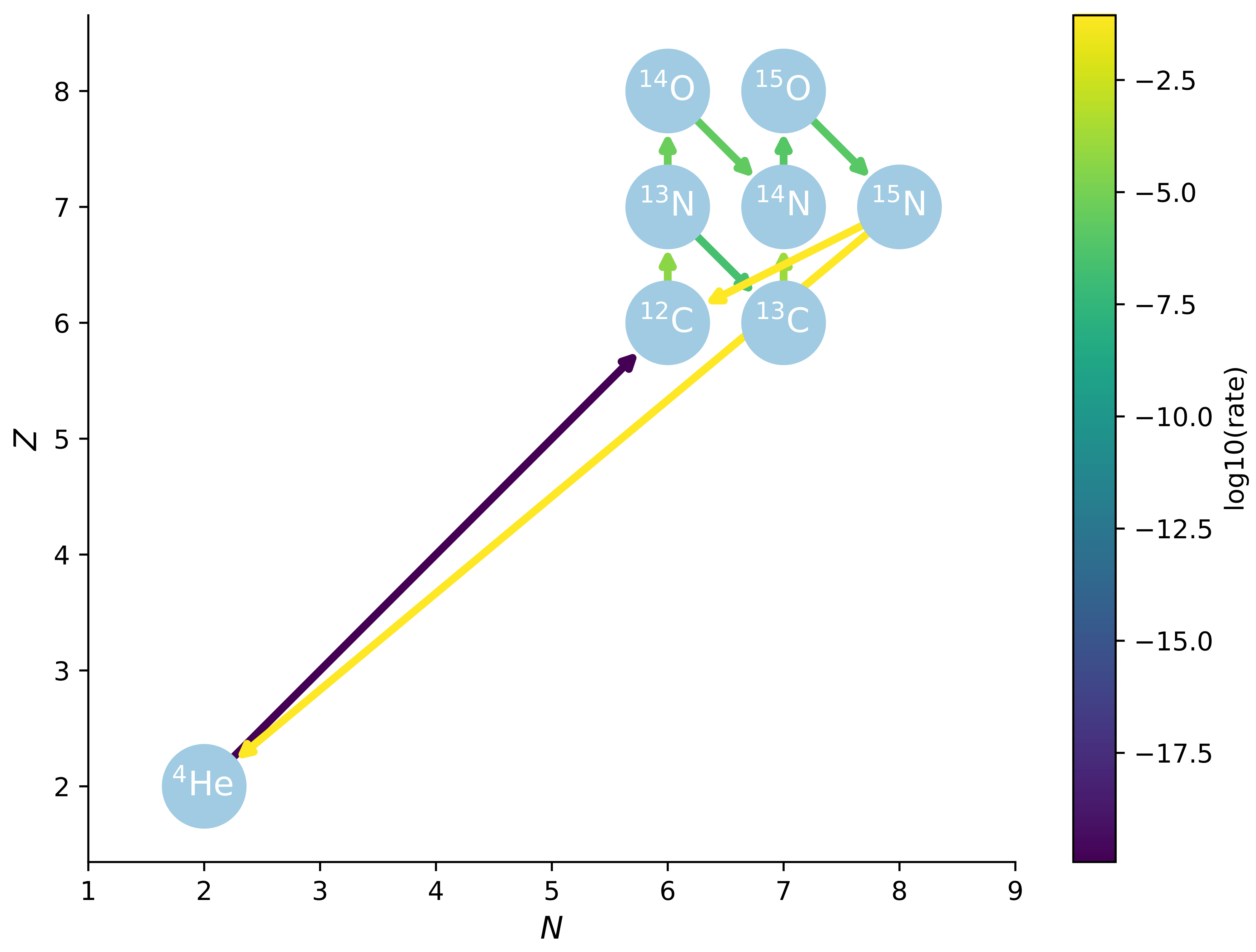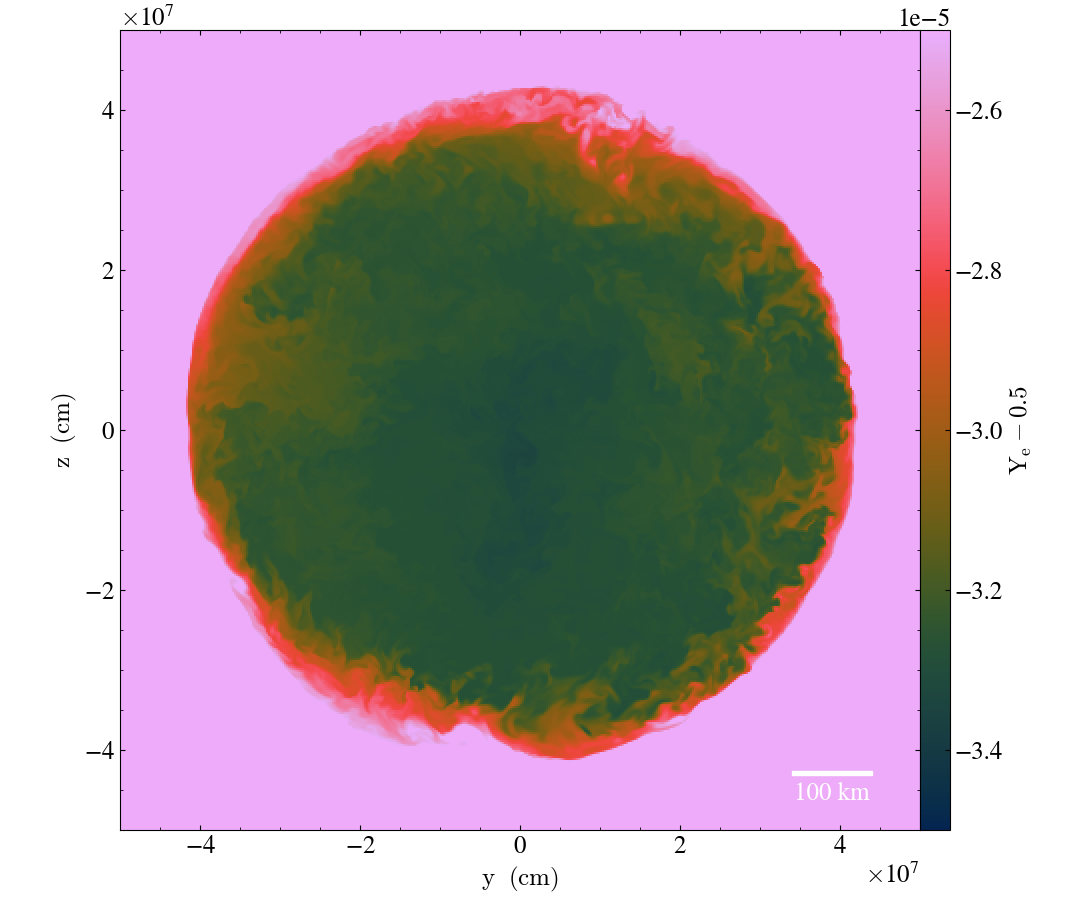
Overview |
|
AMReX |
|
People |
|
Publications |
Donald Willcox
Project Scientist, Applied Mathematics and Computational Research Division
|
Contact InformationDonald WillcoxMS 50A-3111 Lawrence Berkeley National Lab 1 Cyclotron Rd. Berkeley, CA 94720 510-486-6900 (fax) |
 |
Affiliation and Research Interests
I was a project scientist in the Center for Computational Sciences and Engineering (CCSE) in the Computing Sciences Area at the Lawrence Berkeley National Laboratory. My research interests are in computational astrophysics, specifically in designing large scale hydrodynamics simulations of thermonuclear supernova explosions and progenitors. I am also interested in accelerating these algorithms for GPU-based supercomputers, especially the ODE solvers required for time integration of nuclear reaction networks.
Current Projects
Reaction Network ODE integration on GPUs
 I am additionally working
on nuclear reaction network integration for GPUs
using CUDA. Typical nuclear reaction networks can be
quite stiff and are commonly solved with implicit
multistep ODE integration methods such as the BDF
method implemented in VODE and CVODE. To take
advantage of GPU accelerators, I first ported VODE
to CUDA Fortran and shown are some early test
results for a variety of small reaction networks. I am additionally working
on nuclear reaction network integration for GPUs
using CUDA. Typical nuclear reaction networks can be
quite stiff and are commonly solved with implicit
multistep ODE integration methods such as the BDF
method implemented in VODE and CVODE. To take
advantage of GPU accelerators, I first ported VODE
to CUDA Fortran and shown are some early test
results for a variety of small reaction networks. My current work involves scaling to larger reaction networks by adapting the CUDA support in CVODE to integrate the ODE systems in a grid of cells together with control of batched GPU operations and optimized GPU linear algebra. This work is in collaboration with the SUNDIALS group at Lawrence Livermore Lab. |
Code Generation for Reaction Networks with
pynucastro
 Related to
my work on nuclear reaction networks for GPUs and
for science applications, I collaborate with Michael
Zingale from Stony Brook University and others to
develop pynucastro. pynucastro is a Python code
providing an accessible interface to nuclear
reaction rate parameterizations, weak rate
tabulations, and atomic mass data that allows for
easy construction of reaction Related to
my work on nuclear reaction networks for GPUs and
for science applications, I collaborate with Michael
Zingale from Stony Brook University and others to
develop pynucastro. pynucastro is a Python code
providing an accessible interface to nuclear
reaction rate parameterizations, weak rate
tabulations, and atomic mass data that allows for
easy construction of reactionnetworks as well as visualization and exploration. pynucastro currently supports JINA Reaclib reaction rates as well as selected weak rate tabulations. pynucastro is also capable of code generation for reaction network ODE systems, supplying the right hand side and Jacobian in ready-to-compile Fortran modules and generated the reaction network I am currently using for the convective Urca process simulations. Recently I added CUDA Fortran support as a step towards GPU integration for large reaction networks. |
The Convective Urca Process
 The convective Urca process in white
dwarf stars near the Chandrasekhar-mass can occur
during the late stages of convective simmering in
the single degenerate progenitor model for Type Ia
(thermonuclear) supernovae. The A=23 convective Urca
process couples electron captures onto 23Na
to beta decays of 23Ne via convective
currents driven by fusion of 12C in the
core of such a white dwarf as it slowly approaches
thermonuclear runaway. The energy transport and
neutrino losses due to these weak nuclear reactions
couple to convection and determine the composition
structure of the convection zone near runaway and
are thought to influence the dynamics of the
runaway. Realistic simulations of this process are
challenging because of the inherently 3-D nature of
convection and the long timescales involved during
the convective simmering phase. I am using the low
Mach number code Maestro together with a nuclear
reaction network consisting of carbon burning and
the A=23 weak Urca reactions to simulate the
convective Urca process over a range of central
conditions. The convective Urca process in white
dwarf stars near the Chandrasekhar-mass can occur
during the late stages of convective simmering in
the single degenerate progenitor model for Type Ia
(thermonuclear) supernovae. The A=23 convective Urca
process couples electron captures onto 23Na
to beta decays of 23Ne via convective
currents driven by fusion of 12C in the
core of such a white dwarf as it slowly approaches
thermonuclear runaway. The energy transport and
neutrino losses due to these weak nuclear reactions
couple to convection and determine the composition
structure of the convection zone near runaway and
are thought to influence the dynamics of the
runaway. Realistic simulations of this process are
challenging because of the inherently 3-D nature of
convection and the long timescales involved during
the convective simmering phase. I am using the low
Mach number code Maestro together with a nuclear
reaction network consisting of carbon burning and
the A=23 weak Urca reactions to simulate the
convective Urca process over a range of central
conditions. |
Previous Work
I completed my PhD in Physics at Stony Brook University
in August 2018 working with Alan Calder and Michael
Zingale on a variety of projects, some of which I am still
involved with. I first explored supernovae explosion
simulations from newly proposed "hybrid"
carbon-oxygen-neon white dwarfs in the single degenerate
progenitor paradigm for Type Ia supernovae. These
simulations consisted of a suite of 2-D simulations using
the Flash code. Since then I have worked on understanding
the convective Urca process using the low Mach
hydrodynamics code Maestro, developed by LBNL and Stony
Brook. Along the way I've explored interests in reaction
network code generation, GPU acceleration for ODE
integration, and uncertainty quantification for
simulations.
Publications
- M. M. Hoffman, D. E. Willcox, M. P. Katz, S. Ferson, F. D. Swesty, A. C. Calder, On the Quantification of Incertitude in Astrophysical Simulation Codes, manuscript in preparation.
- M. Zingale, K. Eiden, Y. Cavecchi, A. Harpole, J. B. Bell, M. Chang, I. Hawke, M. P. Katz, C. M. Malone, A. J. Nonaka, D. E. Willcox, W. Zhang, Toward Resolved Simulations of Burning Fronts in Thermonuclear X-ray Bursts, submitted to the proceedings of the AstroNum 2018 conference, [arXiv].
- A. C. Calder, D. E. Willcox, C. J. DeGrendele, D. Shangase, M. Zingale, D. M. Townsley, Thermonuclear (Type Ia) Supernovae and Progenitor Evolution, submitted to the proceedings of the AstroNum 2018 conference.
- A. C. Calder, M. M. Hoffman, D. E. Willcox, M. P. Katz, F. D. Swesty, S. Ferson, Quantification of Incertitude in Black Box Simulation Codes, 2018, Journal of Physics: Conference Series, 1031, 012016, [doi].
- D. E. Willcox and M. Zingale, pynucastro: an interface to nuclear reaction rates and code generator for reaction network equations, 2018, Journal of Open Source Software, 3(23), 588, [doi].
- M. Zingale, A. S. Almgren, M. G. Barrios Sazo, V. E. Beckner, J. B. Bell, B. Friesen, A. M. Jacobs, M. P. Katz, C. M. Malone, A. J. Nonaka, D. E. Willcox, W. Zhang, Meeting the Challenges of Modeling Astrophysical Thermonuclear Explosions: Castro, Maestro, and the AMReX Astrophysics Suite, 2018, Journal of Physics: Conference Series, 1031, 012024, [doi].
- A. C. Calder, B. K. Krueger, A. P. Jackson, D. E. Willcox, B. J. Miles, D. M. Townsley, Cosmic Chandlery with Thermonuclear Supernovae, 2017, Journal of Physics: Conference Series, 837, 012005, [doi].
- D. E. Willcox, D. M. Townsley, A. C. Calder, P. Denissenkov, F. Herwig, Type Ia Supernova Explosions From Hybrid Carbon-Oxygen-Neon White Dwarf Progenitors 2016, Astrophysical Journal, 832, 13, [doi].
Conference Talks
- Stellar Explosion Mechanics: Properties and Physical Processes in White Dwarf Interiors, Student Seminar Series, Institute for Advanced Computational Sciences, Stony Brook University, Stony Brook, NY, 11/15/2017.
- The Dynamics and Origins of Thermonuclear (Type Ia) Supernovae, Interdisciplinary Theoretical and Computational Physical Science meeting, Tokyo Institute of Technology, Tokyo, Japan, 10/05/2017.
- A Brief Tour of the AMReX Astrophysics Suite of Codes, NY Area Computational Hydro Workshop, Flatiron Institute/CCA, New York, NY, 09/29/2017.
- White Dwarfs as Type Ia Supernovae Progenitors, Research Caf� Series, Center for Inclusive Education, Stony Brook University, Stony Brook, NY, 06/28/2017.
- Simulations of Various White Dwarf Progenitor Models for Type Ia Supernovae Current Challenges in the Physics of White Dwarf Stars (invited talk), Santa Fe, NM, 06/16/2017.
- Status of Recent Work for Type Ia Supernovae Progenitors: Hybrid C-O-Ne White Dwarfs, the Convective Urca Process, and Accelerated Reaction Networks, Astrophysics Seminar, Los Alamos National Laboratory, Los Alamos, NM, 06/14/2017.
- Elucidating the Convective Urca Process in Pre-Supernova White Dwarfs Using Three-Dimensional Simulations, Junior Researchers Workshop, JINA-CEE Frontiers in Nuclear Astrophysics Meeting, Michigan State University, East Lansing, MI, 02/05/2017.
Conference Posters
- D. E. Willcox, A. Jacobs, X. Li, M. Zingale, pynucastro: Code Generation and Visualization for Nuclear Reaction Networks, Bay Area Scientific Computing Day 2018, Sandia National Laboratories, Livermore, CA, December 7, 2018.
- D. E. Willcox, D. M. Townsley, M. Zingale, A. C. Calder, Three Dimensional Simulations of the Convective Urca Process in White Dwarf Progenitors of Type Ia Supernovae, Current Challenges in the Physics of White Dwarf Stars, Santa Fe, NM, June 12-16, 2017.
- D. E. Willcox, D. M. Townsley, M. Zingale, A. C. Calder, Elucidating the Convective Urca Process in Pre-Supernova White Dwarfs Using Three-Dimensional Simulations, JINA-CEE Frontiers in Nuclear Astrophysics Meeting, Lansing, MI, February 7-9, 2017.
- D. E. Willcox, D. M. Townsley, M. Zingale, A. C. Calder, Three-Dimensional Simulations of the Convective Urca Process in Pre-Supernova White Dwarfs, American Astronomical Society Meeting 229, 244.05, 2017.
- M. M. Hoffman, M. P. Katz, D. E. Willcox, S. Ferson, F. D. Swesty, A. C. Calder, On the Quantification of Incertitude in Astrophysical Simulation Codes, American Astronomical Society Meeting 229, 154.27, 2017.
- D. E. Willcox, D. M. Townsley, A. C. Calder, P. Denissenkov, F. Herwig, Thermonuclear Supernova Explosions From Hybrid White Dwarf Progenitors, American Astronomical Society Meeting 227, 237.17, 2016.
- D. E. Willcox, D. M. Townsley, A. C. Calder, P. Denissenkov, F. Herwig, A Comparison of Type Ia Supernovae with C-O and Hybrid C-O-Ne White Dwarf Progenitors, F.O.E. Fifty-One Erg International Workshop, North Carolina State University, NC, 2015.
- D. E. Willcox, D. M. Townsley, A. C. Calder, A Study of Steady-State Detonation Structures for Hybrid C, O, Ne White Dwarf Models, International Conference (on) Type Ia Supernovae: Progenitors, Explosions, and Cosmology, University of Chicago, IL, 2014.
- D. E. Willcox, M. A. Reber, Y. Chen, K. Halder, T. Allison, Imaging Molecular Structure With High Harmonics, Chemistry Research Day, Stony Brook University, NY, 2013.
- M. A. Reber, Y. Chen, D. E. Willcox, T. Allison, Cavity-Enhanced Transient Absorption Spectroscopy, Chemistry Research Day, Stony Brook University, NY, 2013.